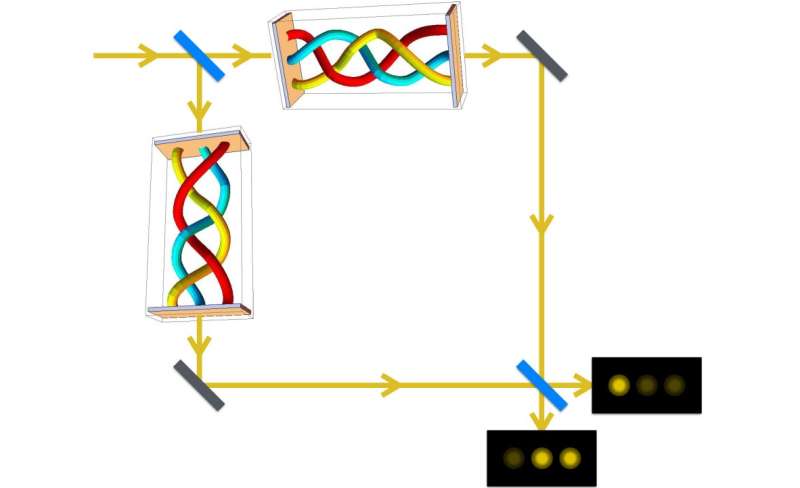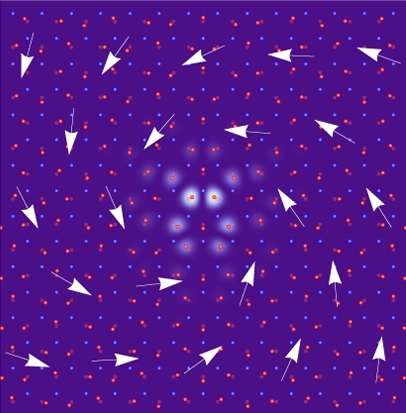August 22, 2016 feature
Physicists propose method for braiding light

(Phys.org)—Physicists have proposed a way to braid three beams of light by guiding the beams along swirling, vortex-shaped defects in the optical medium through which the beams travel. The braided light would have an unusual "non-Abelian" nature, meaning that its phase would depend on the exact order in which the defects are wound around each other.
The physicists, Thomas Iadecola, Thomas Schuster, and Claudio Chamon at Boston University, have published a paper on the non-Abelian braiding of light in a recent issue of Physical Review Letters.
As the scientists explain, non-Abelian braided light is the optical analogue of a similar phenomenon that occurs in electronic systems, called non-Abelian Berry phases, which have been known about since the 1980s. The electronic medium that electrons propagate through can be engineered to have topological defects, such as vortices, that can be wound around each other to form a braid. Within the electronic medium, zero-energy states called zero modes, which carry fractional charges of the full electron charge, bind to the braided defects and act as guides for the propagating charges.
The new study marks the first time that zero modes, along with their ability to be braided, have theoretically been shown to exist in optical systems. The researchers propose that a set of waveguides can be arranged in a pattern containing vortices, where the precise positions of the vortices are etched into the optical medium using a femtosecond laser. Each vortex can trap a beam of light, so that light traces out a braided path as it propagates through the medium.
"The greatest significance of this work is that it demonstrates the existence of defects with non-Abelian braiding in optical, rather than electronic, systems," Iadecola told Phys.org. "Such defects are actively sought-after in the context of solid-state electronic systems, but the optical analogue that we suggest in this work could provide another avenue to observe non-Abelian braiding. The advantage of the optical systems we consider is that they have a high degree of tunability that allows one to precisely control the paths of the defects during braiding."
In both the electronic and optical systems, the non-Abelian nature of the braiding process means that performing the same braids in a different order yields different results. The non-Abelian nature arises directly from the braided topology of the zero modes, and is different from most processes that guide charges or light, which do not depend on the order of the steps in the process.

"The fact that the braided light behaves in a non-Abelian way is interesting because it constitutes a vivid manifestation of topology in physics," Iadecola said. "The vortices that are used to trap the light and braid it are topological defects in the ordered pattern of the waveguide lattice. We believe that it may be possible to use these 'topological' waveguide lattices in optical circuit elements; this is an avenue that we are interested in pursuing further."
Another interesting aspect of the optical zero modes is that, while they occur at the quantum level with a small number of photons, the phenomenon persists even with large numbers of photons. For this reason, braided light can be understood using both quantum and classical descriptions of light.
The researchers expect that braided light can be experimentally realized with current technology, and they have proposed an experiment to do so. The experiment uses an interferometer in which light is braided in a different order in the two arms. Detectors then measure whether different orders of braiding produce different phases of light, giving evidence of the light's non-Abelian nature.
"We intend to work with experimentalists in the waveguide optics field to implement a version of the experiment we proposed," Iadecola said. "We would also like to determine whether there are other optics platforms that could support the 'topological guided modes' we study in the paper."
More information: Thomas Iadecola, Thomas Schuster, and Claudio Chamon. "Non-Abelian Braiding of Light." Physical Review Letters. DOI: 10.1103/PhysRevLett.117.073901. Also at arXiv:1509.05408 [cond-mat.mes-hall]
Journal information: Physical Review Letters
© 2016 Phys.org


















